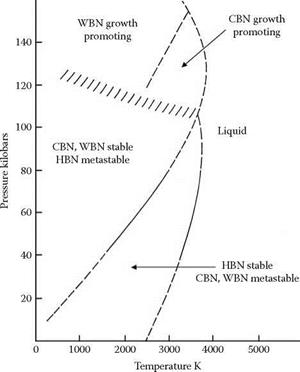3.4.6 Development of CBN
CBN is the final and most recent of the four major abrasive types, and the second hardest superabrasive after diamond. Trade names include Borazon (from GE who first synthesized it commercially), Amborite and Amber Boron Nitride (after De Beers), or in Russian literature as Elbor, Cubonite, or P-BN.
Boron nitride at room temperatures and pressures is made using the reaction:
BCl3 + NH3 ^ BN + 3HCl
The resulting product is a white slippery substance with a hexagonal layered atomic structure called HBN (or a-BN) similar to graphite but with alternating nitrogen and boron atoms. Nitrogen and boron lie on either side of carbon in the periodic table, and it was postulated that high temperatures and pressures could convert HBN to a cubic structure similar to diamond. This was first shown to be the case by a group of scientists under Wentdorf at GE in 1957. The first commercial product was released 12 years later in 1969.
Both the cubic (CBN) and wurtzitic (WBN or y-BN) forms are created at comparable pressures and temperatures to those for carbon. Again, the key to successful synthesis was the selection of a suitable solvent to reduce conditions to a more manageable level. The chemistry of BN was quite different to carbon; for example, bonding was not pure sp3 but 25% ionic, and BN did not show the same affinity for transition metals. The successful solvent/catalyst turned out to be any one of a large number of metal nitrides, borides, or oxide compounds of which the earliest commercial one used (probably with some additional doping) was Li3N. This allowed economic yields at 60 kbar, 1,600°C, and <15-min cycle times.
3.4.7 Shape and Structure of CBN
As with diamond crystal growth, CBN grain shape is governed by the relative growth rates on the octahedral (111) and cubic planes. However, the (111) planes dominate and, because of the presence of both B and N in the lattice, some (111) planes are positive terminated by B atoms and some are negative terminated by N atoms. In general, B (111) plane growth dominates and the resulting
|
FIGURE 5.16 Phase diagram for cubic boron nitride. |
crystal morphology is a truncated tetrahedron. Twinned plates and octahedra are also common. The morphology can be driven toward the octahedral or cubo-octahedral morphologies by further doping and/or careful control of the pressure-temperature conditions.

